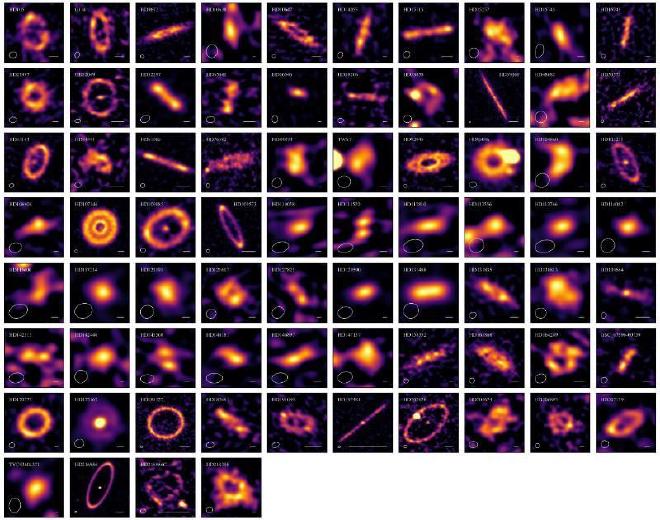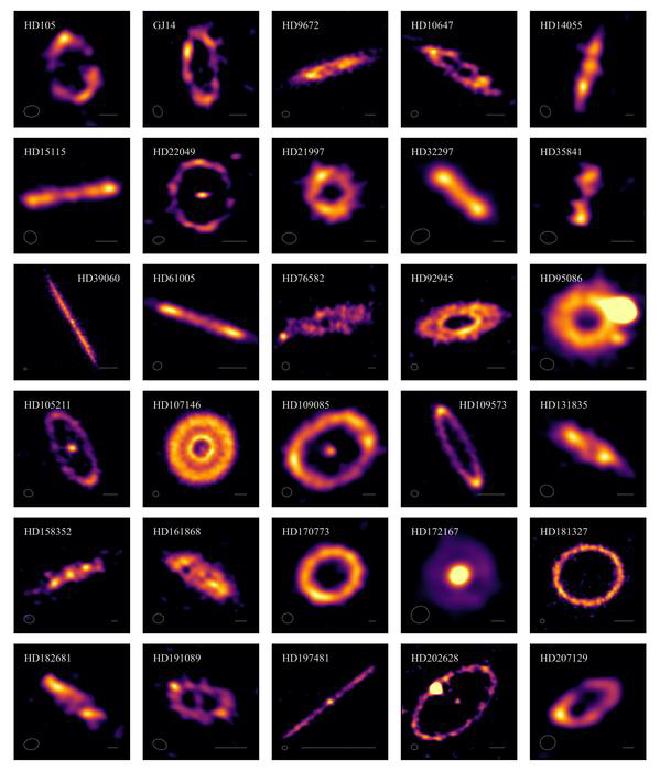En un estudio histórico, astrofísicos revelan la estructura de 74 cinturones de exocometas que orbitan estrellas cercanas
Table of Contents

El estudio REASONS (REsolved ALMA and SMA Observations of Near Stars) establece un hito tan importante en el estudio de los cinturones exocometarios a causa de que sus imágenes y análisis revelan dónde se encuentran los guijarros y, por tanto, los exocometas. Por lo general, se encuentran entre decenas y cientos de au -unidades astronómicas- (la distancia entre la Tierra y el Sol) de su estrella central.

En estas regiones, hace tanto frío (-250 a -150 grados Celsius) que la mayoría de los compuestos, incluida el agua, están congelados en forma de hielo en estos exocometas. Por tanto, lo que los astrofísicos observan es dónde se encuentran las reservas de hielo de los sistemas planetarios. REASONS es el primer programa que devela la estructura de estos cinturones y entrega una gran muestra de 74 sistemas exoplanetarios.
Atacama Large Millimeter/submillimeter Array (ALMA) es un conjunto de 66 radiotelescopios en el desierto de Atacama en el norte de Chile, mientras que el Submillimeter Array (SMA) es un conjunto similar de ocho elementos en Hawaii. Ambos observan radiación electromagnética en longitudes de onda milimétricas y submilimétricas. Este estudio echó mano de ambos para producir imágenes que han proporcionado más información que nunca sobre las poblaciones de exocometas.
“Los exocometas son cantos rodados de roca y hielo, de al menos 1 km de tamaño, que chocan entre sí dentro de estos cinturones para producir los guijarros que observamos aquí con los conjuntos de telescopios ALMA y SMA. Los cinturones exocometarios se encuentran en al menos el 20% de los sistemas planetarios, incluido nuestro propio Sistema Solar”, afirmó Luca Matrà, profesor asociado de la Trinity’s School of Physics y autor principal del artículo de investigación que acaba de publicarse en la revista Astronomy and Astrophysics.
El Dr. Sebastián -Seba- Marino, investigador de la Royal Society University en la Universidad de Exeter, y coautor de este estudio, explicó que “las imágenes revelan una notable diversidad en la estructura de los cinturones. Algunos son anillos estrechos, como en la imagen canónica de un ‘cinturón’ como el cinturón Edgeworth-Kuiper de nuestro Sistema Solar. Pero una mayor cantidad de ellos son anchos y probablemente sea mejor describirlos como “discos” en lugar de anillos”.
Algunos sistemas tienen múltiples anillos/discos, parte de los cuales son excéntricos, lo que proporciona evidencia de que todavía hay planetas indetectables y que su gravedad afecta la distribución de los guijarros en estos sistemas.

“El poder de un estudio de gran volumen, como REASONS reside en revelar propiedades y tendencias a nivel de toda la población” de cuerpos investigados, explicó Matrà.
“Por ejemplo, confirmó que el número de guijarros disminuye en los sistemas planetarios más antiguos a medida que los cinturones se quedan sin exocometas más grandes que chocan entre sí, pero demostró por primera vez que esta disminución de guijarros es más rápida si el cinturón está más cerca de la estrella central. También mostró indirectamente –a través del espesor vertical de los cinturones– que es probable que en estos cinturones estén presentes objetos no observables de hasta 140 kilómetros del tamaño de la Luna".
El Dr. David Wilner, astrofísico senior del Centro de Astrofísica | Harvard & Smithsonian, subrayó que “los conjuntos como ALMA y SMA utilizados en este trabajo son herramientas extraordinarias que continúan brindándonos nuevos e increíbles conocimientos sobre el universo y su funcionamiento. El sondeo REASONS requirió un gran esfuerzo comunitario y tiene un valor de legado increíble, con múltiples vías potenciales para investigaciones futuras".
-
Los investigadores involucrados en este trabajo colaborativo contaron con el apoyo de fondos de Taighde Éireann – Research Ireland; el programa de investigación e innovación Horizonte 2020 de la Unión Europea con una subvención Marie Sklodowska-Curie; el Smithsonian Institute; la Royal Society; el National Science and Technology Council of Taiwan; una beca senior Beatriz Galindo del Ministerio de Ciencia, Innovación y Universidades de España; el National Science Foundation Graduate Research Fellowship Program, de Estados Unidos.
-
El paper REsolved ALMA and SMA Observations of Nearby Stars (REASONS) A population of 74 resolved planetesimal belts at millimetre wavelengths, fue publicado hoy en Astronomy and Astrophysics. Autores: L. Matrà, S. Marino, D. J. Wilner, G. M. Kennedy, M. Booth, A. V. Krivov, J. P. Williams, A. M. Hughes, C. del Burgo, J. Carpenter, C. L. Davies, S. Ertel, Q. Kral, J.-F. Lestrade, J. P. Marshall, J. Milli, K. I. Öberg, N. Pawellek, A. G. Sepulveda, M. C. Wyatt, B. C. Matthews & M. MacGregor
-
El artículo Astrophysicists reveal structure of 74 exocomet belts orbiting nearby stars in landmark survey, fue publicado hoy en sección de noticias del sitio de TCD.
English version #
Astrophysicists reveal structure of 74 exocomet belts orbiting nearby stars in landmark survey #
Astrophysicists led by a team from Trinity College Dublin have – for the first time – imaged a large number of exocomet belts around nearby stars, and the tiny pebbles within them. The crystal-clear images show light being emitted from these millimetre-sized pebbles within the belts that orbit 74 nearby stars of a wide variety of ages – from those that are just emerging from birth to those in more mature systems like our own Solar System.

The REASONS (REsolved ALMA and SMA Observations of Nearby Stars) study marks such a significant milestone in the study of exocometary belts because its images and analyses reveal where the pebbles, and hence the exocomets, are located. They are typically tens to hundreds of au (the distance from Earth to the Sun) from their central star.
In these regions, it is so cold (-250 to -150 degrees Celsius) that most compounds including water are frozen as ice on these exocomets. What the astrophysicists are therefore observing is where the ice reservoirs of planetary systems are located. REASONS is the first program to unveil the structure of these belts for a large sample of 74 exoplanetary systems.
The Atacama Large Millimeter/submillimeter Array (ALMA) is an array of 66 radio telescopes in the Atacama Desert of northern Chile, while the Submillimeter Array (SMA) is a similar eight-element array in Hawaii. Both observe electromagnetic radiation at millimetre and submillimetre wavelengths. This study used both to produce the images that have provided more information on populations of exocomets than ever before.
“Exocomets are boulders of rock and ice, at least 1 km in size, which smash together within these belts to produce the pebbles that we observe here with the ALMA and SMA arrays of telescopes. Exocometary belts are found in at least 20% of planetary systems, including our own Solar System,” said Luca Matrà, Associate Professor in Trinity’s School of Physics, and senior author of the research article that has just been published in Astronomy and Astrophysics.
Dr Sebastián -Seba- Marino, Royal Society University Research Fellow at the University of Exeter, and coauthor in this study, added: “The images reveal a remarkable diversity in the structure of belts. Some are narrow rings, as in the canonical picture of a ‘belt’ like our Solar System’s Edgeworth-Kuiper belt. But a larger number of them are wide, and probably better described as ‘disks’ rather than rings.”
Some systems have multiple rings/disks, some of which are eccentric, which provides evidence that yet undetectable planets are present and their gravity affects the distribution of pebbles in these systems.
“The power of a large study like REASONS is in revealing population-wide properties and trends,” explained Prof. Matrà.

“For example, it confirmed that the number of pebbles decreases for older planetary systems as belts run out of larger exocomets smashing together, but showed for the first time that this decrease in pebbles is faster if the belt is closer to the central star. It also indirectly showed – through the belts’ vertical thickness – that unobservable objects as large as 140 km to Moon-size are likely present in these belts."
Dr David Wilner, Senior Astrophysicist at the Center for Astrophysics | Harvard & Smithsonian, underlined: “Arrays like the ALMA and SMA used in this work are extraordinary tools that are continuing to give us incredible new insights into the universe and its workings. The REASONS survey required a large community effort and has an incredible legacy value, with multiple potential pathways for future investigation."
“For example, the REASONS dataset of belt and planetary system properties will enable studies of the birth and evolution of these belts, as well as follow-up observations across the wavelength range, from JWST to the next generation of Extremely Large Telescopes and ALMA’s upcoming ARKS Large Program to zoom even further onto the details of these belts.”
-
The researchers involved in this collaborative work were supported by funding from Taighde Éireann – Research Ireland; the European Union’s Horizon 2020 research and innovation programme under a Marie Sklodowska-Curie grant; the Smithsonian Institution; the Royal Society; the National Science and Technology Council of Taiwan; a Beatriz Galindo senior fellowship from the Spanish Ministry of Science, Innovation and Universities; the National Science Foundation Graduate Research Fellowship Program from United States.
-
The paper REsolved ALMA and SMA Observations of Nearby Stars (REASONS) A population of 74 resolved planetesimal belts at millimetre wavelengths, was published today in Astronomy and Astrophysics. Authors: L. Matrà, S. Marino, D. J. Wilner, G. M. Kennedy, M. Booth, A. V. Krivov, J. P. Williams, A. M. Hughes, C. del Burgo, J. Carpenter, C. L. Davies, S. Ertel, Q. Kral, J.-F. Lestrade, J. P. Marshall, J. Milli, K. I. Öberg, N. Pawellek, A. G. Sepulveda, M. C. Wyatt, B. C. Matthews & M. MacGregor
-
The article Astrophysicists reveal structure of 74 exocomet belts orbiting nearby stars in landmark survey, was published today in the TCD’s new section site.


